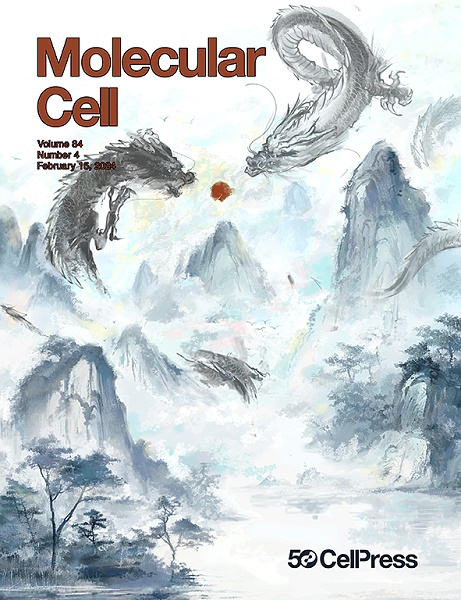Dual modes of ZFC3H1 confer selectivity in nuclear RNA sorting
IF 14.5
1区 生物学
Q1 BIOCHEMISTRY & MOLECULAR BIOLOGY
引用次数: 0
Abstract
The export and degradation pathways compete to sort nuclear RNAs, yet the default pathway remains unclear. Sorting of mature RNAs to degradation, facilitated by the exosome co-factor poly(A) exosome targeting (PAXT), is particularly challenging for their resemblance to mRNAs intended for translation. Here, we unveil that ZFC3H1, a core PAXT component, is co-transcriptionally loaded onto the first exon/intron of RNA precursors (pre-RNAs). Interestingly, this initial loading does not lead to pre-RNA degradation, as ZFC3H1 adopts a “closed” conformation, effectively blocking exosome recruitment. As processing progresses, RNA fate can be reshaped. Longer RNAs with more exons are allowed for nuclear export. By contrast, short RNAs with fewer exons preferentially recruit transient PAXT components ZC3H3 and RBM26/27 to the 3′ end, triggering ZFC3H1 “opening” and subsequent exosomal degradation. Together, the decoupled loading and activation of ZFC3H1 pre-configures RNA fate for decay while still allowing a switch to nuclear export, depending on mature RNA features.

ZFC3H1的双重模式赋予核RNA分拣选择性
输出和降解途径竞相对核 RNA 进行分拣,但默认途径仍不清楚。外泌体辅助因子多聚(A)外泌体靶向(PAXT)促进了成熟 RNA 的降解分拣,由于它们与用于翻译的 mRNA 相似,这尤其具有挑战性。在这里,我们揭示了 PAXT 核心部件 ZFC3H1 通过共转录加载到 RNA 前体(pre-RNA)的第一个外显子/内含子上。有趣的是,由于 ZFC3H1 采用了 "封闭 "构象,有效阻止了外泌体的招募,因此这种初始加载不会导致前 RNA 降解。随着加工的进行,RNA的命运也会发生改变。外显子较多的长 RNA 可以进行核输出。与此相反,外显子较少的短 RNA 会优先将瞬时 PAXT 成分 ZC3H3 和 RBM26/27 募集到 3′末端,从而触发 ZFC3H1 "打开 "并随后被外泌体降解。ZFC3H1 的解耦加载和激活共同预设了 RNA 的衰变命运,同时还允许根据成熟 RNA 的特征切换到核输出。
本文章由计算机程序翻译,如有差异,请以英文原文为准。
求助全文
约1分钟内获得全文
求助全文
来源期刊

Molecular Cell
生物-生化与分子生物学
CiteScore
26.00
自引率
3.80%
发文量
389
审稿时长
1 months
期刊介绍:
Molecular Cell is a companion to Cell, the leading journal of biology and the highest-impact journal in the world. Launched in December 1997 and published monthly. Molecular Cell is dedicated to publishing cutting-edge research in molecular biology, focusing on fundamental cellular processes. The journal encompasses a wide range of topics, including DNA replication, recombination, and repair; Chromatin biology and genome organization; Transcription; RNA processing and decay; Non-coding RNA function; Translation; Protein folding, modification, and quality control; Signal transduction pathways; Cell cycle and checkpoints; Cell death; Autophagy; Metabolism.
 求助内容:
求助内容: 应助结果提醒方式:
应助结果提醒方式:


